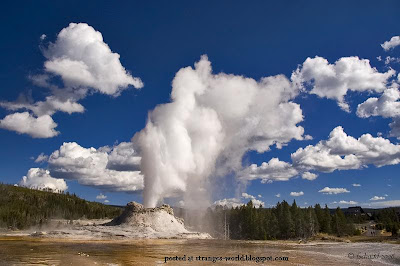Duniapustaka.com
Minggu, 25 Juli 2010
Minggu, 11 Juli 2010
12 Unfortunate Beards and Mustaches for a Mugshot












What a dickhead... literally.
Nastiest Toothpaste

The Twin Lotus Original Herbal
Chocolate Toothpaste

In 2005, Unilever Philippines marketed a limited edition of chocolate flavored fluoride toothpaste. Closeup Flavalicious toothpaste in Choco Loco might not be as strange as it sounds, however: The research of Tulane University doctoral candidate Arman Sadeghpour shows that an extract of cocoa powder protects teeth, and is in fact, more effective than fluoride when it comes to cavity prevention.
Bacon Toothpaste

Bacon is getting to be a plenty popular thing, and everybody is coming up with bacon products that have sprawled out from just the dining table. With this toothpaste you can clean those pearly whites with bacon-flavoured toothpaste and have a long-lasting
Whiskey Toothpaste

The ultimate he-man toothpaste, flavored with scotch or bourbon. The night-before feeling on the morning after.
Two Way Toothpaste

A two way toothpaste, ideal for those who get angry with their partner for squeezing the toothpaste from the front. Simply open the other end and squeeze from the back as demonstrated below. Also quite useful for getting the last of the paste out of the bottom.
Monkey Brand Black Toothpaste

Close your eyes and imagine this.
E-mail Diamant Rouge Toothpaste

This weird toothpaste called Email Diamant Rouge is French, and apparently, it's been around since 1893. Guess
Champagne Toothpaste

If you prefer Champagne rather than whiskey, this toothpaste is perfect for you. You can have this toothpaste with Champagne flavour for $10/each. Surprise your friends with this unique gift.
Black Japanese Toothpaste

I can think of many uses for everyday charcoal. From art to making myself a burger on the grill, it is definitely useful. However, when I first saw that Korea had Charcoal Toothpaste, I was a little taken aback. Black in color, go figure, it uses the cleaning power and absorption of odor to help clean your mouth and “neutralize the poisons from the body”. I guess someone figured if it is good enough to filter your water then it is good enough to clean your teeth. Japan has had charcoal toothpaste since 2003 when Kobayashi Pharmaceuticals released Sumigaki.
Ice Cream Toothpaste

Tanner's Tasty Paste wants your mouth to smell like
Kamis, 08 Juli 2010
Yellow Stone National Park



Established in 1872, Yellowstone National Park is America's first national park. Located in Wyoming, Montana, and Idaho, it is home to a large variety of wildlife including grizzly bears, wolves, bison, and elk. Preserved within Yellowstone National Park are Old Faithful and a collection of the world's most extraordinary geysers and hot springs, and the Grand Canyon of the Yellowstone.
Lost Cities

The breathtaking city of Petra was a vibrant trading hub that vanished from most maps in the seventh century A.D. It lay beneath a thousand years of dust and debris when, in 1812, a Swiss scholar disguised as a Bedouin trader identified the ruins as the ancient Nabataean capital.
Spread throughout a series of remote desert canyons in southern Jordan, Petra arose more than 2,000 years ago at the crossroads of key caravan trade routes between Arabia, Syria, Palestine, and Egypt. The Nabataeans carved most of the sprawling city's buildings, including temples, tombs, and theaters, directly into the region's towering red sandstone cliffs. Here, a Bedouin walks his camel past Petra's most famous building, Al Khazneh, or the Treasury


Although the archaeological discovery of Machu Picchu came nearly a hundred years ago, historians are still unsure of the function of this ancient Inca citadel.
The Inca had no system of writing and left no written records, and archaeologists have been left to piece together bits of evidence as to why Machu Picchu was built, what purpose it served, and why it was so quickly vacated.

Myth, folklore, mystery, and intrigue surround the ancient city of Troy like no other ruin on Earth. Once thought to be purely imaginary, a prop in Homer's epic poem The Iliad, excavations in northwestern Turkey in 1871 eventually proved that the city indeed existed.
In 1871, German adventurer Heinrich Schliemann began digging at Hisarlik, Turkey, (shown here) in search of the fabled city. His roughshod excavation wrought havoc on the site, but revealed nine ancient cities, each built on top of the next and dating back some 5,000 years. At the time, most archaeologists were skeptical that Troy was among the ruins, but evidence since the discovery suggests the Trojan capital indeed lies within the site.

The Indus Valley civilization was entirely unknown until 1921, when excavations in what would become Pakistan revealed the cities of Harappa and Mohenjo Daro (shown here).
This mysterious culture emerged nearly 4,500 years ago and thrived for a thousand years, profiting from the highly fertile lands of the Indus River floodplain and trade with the civilizations of nearby Mesopotamia.




Nimrud and the Assyrian Empire declined rapidly around 612 B.C., after Nimrud's sister city, Nineveh, fell to the Babylonians.

The ancient city of Persepolis in modern-day Iran was one of four capitals of the sprawling Persian Empire. Built beginning around 520 B.C., the city was a showcase for the empire's staggering wealth, with grand architecture, extravagant works of silver and gold, and extensive relief sculptures such as this one portraying envoys with offerings for the king.
The height of Persian rule lasted from about 550 B.C. until 330 B.C., when Alexander the Great overthrew the ruling Archaemenid dynasty and burned Persepolis to the ground.


The Anasazi arrived in the region as early as A.D. 550, building their homes and cultivating crops on the soaring mesa tops. Around 1150, though, they began to move their dwellings to the alcoves within the canyon walls. Most houses were quite small, but a few reached enormous proportions, housing up 250 people.




